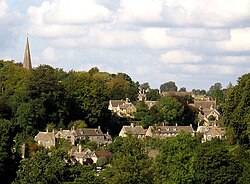Bisley, Gloucestershire
| Bisley | |
| Gloucestershire | |
|---|---|
 A view over Bisley | |
| Location | |
| Grid reference: | SO905065 |
| Location: | 51°45’13"N, 2°8’26"W |
| Data | |
| Population: | 2,142 (2011) |
| Post town: | Stroud |
| Postcode: | GL6 |
| Local Government | |
| Council: | Stroud |
| Parliamentary constituency: |
Stroud |
Bisley is a village in Gloucestershire, about four miles east of Stroud an close by Lypiatt (with which it forms a joint civil parish; 'Bisley-with-Lypiatt').
The once-extensive manor included Stroud and Chalford, Thrupp, Oakridge, Bussage, Througham and Eastcombe.
Church

The parish church is All Saints. The church may originally have been an Anglo-Saxon minster. It was mostly rebuilt in the early 1860s.
Between 1827 and 1857 the Vicar was Thomas Keble, a Tractarian and a pioneer in parish ministry. Thomas Keble was the younger brother of John Keble. His son Thomas Keble succeeded him as Vicar.
About the village
The area is noted for the wealth of its Cotswold stone houses of architectural and historic interest. They include Lypiatt Park, formerly the home of Judge H. B. D. Woodcock and then of the late Modernist sculptor Lynn Chadwick; Nether Lypiatt Manor, formerly the home of Violet Gordon-Woodhouse and later of Prince and Princess Michael of Kent;[1] Daneway (near Sapperton, but within the parish of Bisley); Over Court; Througham Court (repaired in 1929 for the novelist Sir Michael Sadleir by Norman Jewson);[2] and Jaynes Court, formerly the private residence of Simon Isaacs, 4th Marquess of Reading .

Througham Slad Manor is believed to date from the mid-16th century with 18th century additions, the manor was altered in the 1930s by Norman Jewson for W. A. Cadbury. In the 1970s, the house was owned by Mike Oldfield, who installed a recording studio in the barn.
The village prison, which had originally been located in the churchyard, was replaced in 1824 by a two-cell lock-up, where drunks were kept overnight,[3] and petty criminals were detained before appearing before the magistrate. This was often followed by a spell in the stocks or pillory. This building still stands, minus its heavy oak doors and is not now used for the purpose for which it was built.
Bisley has a structure on Wells Road, containing seven spouts forming a public water supply from the Seven Springs and is known for its well dressing.[4]
There is a Saxon wayside cross on the wide verge of Bisley Road, south-west of Stancombe Toll House.
Pictures
-
Stancombe Toll House
-
The Cross-Shaft
-
The plaque
Outside links
| ("Wikimedia Commons" has material about Bisley, Gloucestershire) |
- Bisley Village
- http://www.bisleynews.co.uk Bisley News]
- BBC archive film of Bisley from 1985
- Bisley on Stroud Voices
- OS Bench Marks in the Bisley area
References
- ↑ "BBC - Gloucestershire The Royal County - Nether Lypiatt Manor". http://www.bbc.co.uk/gloucestershire/royal/2003/06/kents.shtml.
- ↑ "Bisley: Introduction - British History Online". https://www.british-history.ac.uk/vch/glos/vol11/pp4-11.
- ↑ GlosGen - Bisley
- ↑ "GlosGen - Bisley Genealogy". http://www.glosgen.co.uk/records/bisley.htm.



